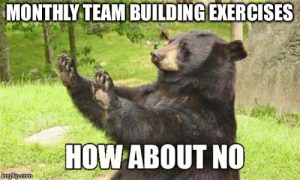
A few days ago, I was browsing other students’ blogs and encountered my group member Eric’s post about team-building exercises. His blog post was about an article explaining how team-building exercises are always a poor solution for team’s problems because many of the problems lead to results of poor leadership.
As well as Eric and the author of the article, I believe there are more losses than gains from team building exercises. Due to different personalities and skills in team members, some of them may not be sociable or good at performing enough. As an introvert person, I have more bad memories of humiliation and embarrassment rather than building team spirit and feeling of unity with my team members.
Team cohesion is important for optimal team functioning, and common organizational problems addressed on articles; lack of communications, organizational culture, leadership, and acknowledgment cannot be solved by only encouraging team building exercises. About this misattribution problem, Eric suggested sharing of the leadership responsibilities amongst members as a preferable alternative of team building exercises. I also would like to suggest the concept of an authentic leader. According to the textbook, authentic leaders share information, encourage open communication, and stick to their ideals . People trust them and this can create a positive energizing effect of increase in team performance.
I also believe that companies should adapt work-related team building activities which allow the team to have the real work done. By doing this, team members can actually learn and practice work-related skills and work effectively with each other. The general meeting to build a strategic plan and clarify the roles and accountability of team members would help as well.
More importantly, I believe team building exercises should happen voluntarily by team members, not by the force. Team building exercises without force can be a lot more fun and be more successful in helping to create team spirit and a positive work atmosphere.eve team building exercise should happen voluntarily by team members, not by the force. Team building exercises without force can be a lot more fun and help to create team spirit and positive work atmosphere.
References
- The Failure of Team-Building Exercises
- Langton, Robbins, Judge, Organizational Behaviour, 7th edition, p. 400.
- Liz Ryan, “The Ugly Truth About Team-Building”, Forbes Magazine, Sept. 22, 2016, http://www.forbes.com/sites/lizryan/2016/09/22/the-ugly-truth-about-team-building/#76f4318e597a

